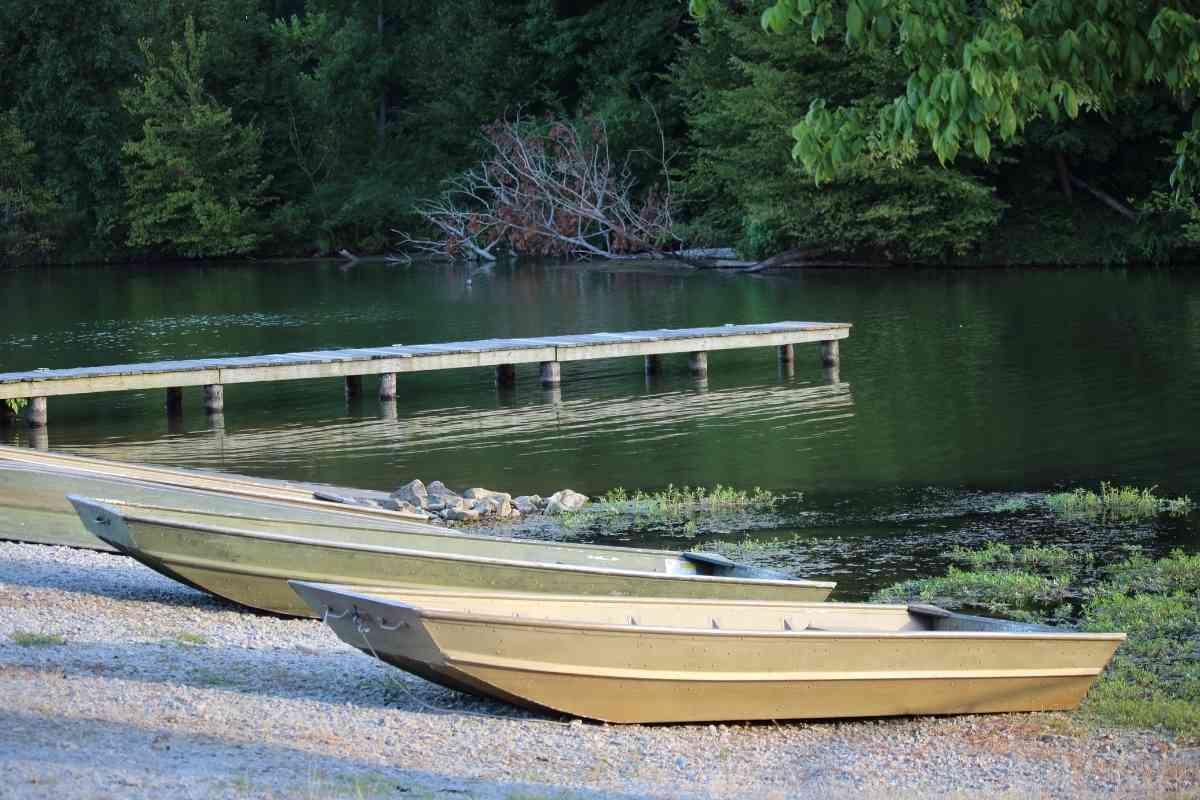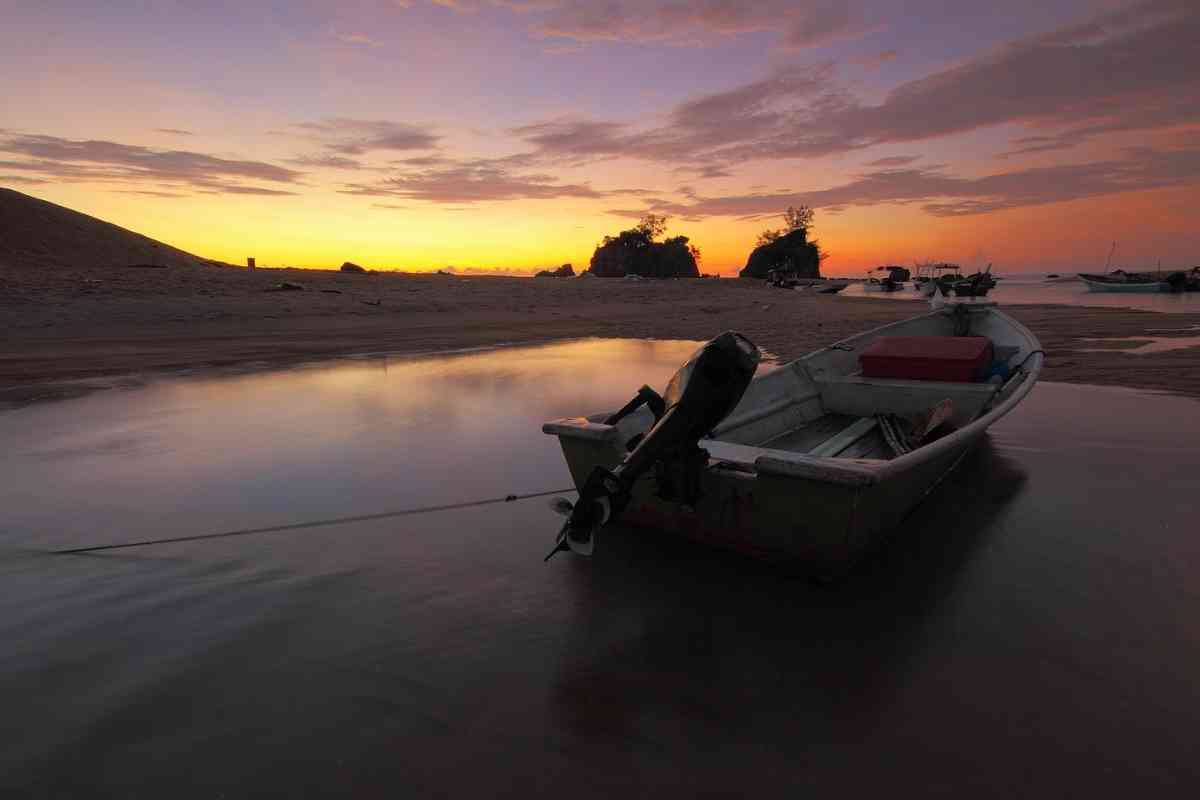Small Flat-Bottom Boats Pros & Cons
Flat bottom boats are an excellent choice for calm, shallow water. They are perfect for inland water while hunting, fishing, transportation, or doing utility work. Small flat bottom boats are prone to swamping and capsizing. Does that mean you should avoid all flat bottom watercraft like Jon boats, gondolas, barges, and skiffs? No, they have many uses in the right conditions. Due to their design, these boats tend to have a shallow draft and low freeboard. Read on to learn the advantages and disadvantages of flat-bottom boats.

Table of Contents
- Small Flat Bottom Boat Characteristics
- When To Use a Small Flat Bottom Boat
- Precautions for Flat Bottom Boats
- When NOT To Use a Small Flat Bottom Boat
- Final Thoughts
Small Flat Bottom Boat Characteristics
Most boats have a v-shaped hull and sit below the water line. A small flat bottom boat sits on top of the water, giving you added stability, a shallower draft and the ability to slide over objects in the water, and an overall smoother ride when used in calm water.
Flat Bottom Advantages
While flat-bottom boats are prone to capsizing and swamping, the advantages in the right circumstances overcome the risks.
Stability
A flat bottom boat has a shallow draft. That means it sits on the water rather than in it. It has excellent stability on calm water and when at rest.
Shallow Draft
A shallow draft means that the keel doesn’t sit low under the waterline. Some flat bottom boats can function in as little as 2” of water.
Sliding
Many flat bottom boats slide over submerged obstacles, allowing hunters and anglers to access nearly any portion of a body of water.
Smooth Ride
Flat bottom boats provide a comfortable ride even at speed because they get on plane quickly. This means that at higher speeds, the hydrodynamic lift supports the majority of weight rather than buoyancy.
Jon boats, flat bottom skiffs, and other small vessels are excellent choices for inland waterways that get extremely shallow. The key is knowing how to use these watercraft to get the most out of them.
When To Use a Small Flat Bottom Boat
Flat bottom vessels have many uses. In many cases, their characteristics are advantageous.
Inland Water Transportation
Many inland bodies of water have shallow areas that only a flat bottom boat will navigate. They offer better access to these waterways.
These boats can be manually propelled or motorized. Venice is famous for its gondolas propelled by poles. Oars and paddles work well too.
Small flat bottom boats work well with trolling motors. You can mount a more powerful outboard motor on larger Jon boats and skiffs.
Utility Work
Similar to transportation needs, utility workers who need to navigate inland lakes and canals find that a flat bottom boat goes more places than other shaped boats.

Hunting and Fishing
Because they sit on top of the water, the current has less effect compared to other hull types. You won’t quickly drift away from the perfect fishing or hunting spot. Easily sliding over obstacles allows you to navigate to shallow banks.
An archer has a stable platform for bow fishing or hunting on these boats. Waterfowlers and other hunters can also fire their rifles and shotguns from a flat bottom boat.
Precautions for Flat Bottom Boats
Flat bottom boats have several uses despite what they are prone to do. Taking some precautions helps you get the most out of your flat bottom boat.
When bringing along bird dogs, only bring the best-trained ones. An excited dog can cause excessive movement swamping water over the sides.
Consider the weight of your load when deer hunting. The low freeboard means you could easily overload your boat with a large harvest.
Be aware of the laws about using and transporting guns when you plan to hunt from your boat. Prevent capsizing upon shooting by turning off the engine, securing the anchor, and staying seated before firing.
Avoid turbulent waters as flat bottom boats are not designed for them. One exception is a river raft, but these flat bottom vessels are intended for calm and rough waters.
Prepare for a possible capsize where you would fall into the water. Have the necessary safety equipment on board such as life preservers and life jackets. Secure electronics in waterproof containers. Carry extra clothes and fire-starting supplies in waterproof bags. You may have to change and keep warm to prevent hypothermia until you can get out of the wilderness.
When NOT To Use a Small Flat Bottom Boat
Your Jon Boat or skiff is perfect for a day of fishing or hunting on calm water. However, some scenarios call for leaving the flat bottom boat behind and choosing another vessel.
Flat bottom boats have shallow draft and low freeboard. The top of the hull sits close to the water line, making it easy for water to splash into the boat.
These two characteristics make a vessel unsuited for rough waters. They don’t sit low enough in the water to provide stability and can take on water over the sides.
River Running
A flat bottom boat should never be taken on whitewater rivers. Turbulent water would soon swamp and capsize the boat. A flat bottom vessel needs calm water to stay stable.
Ocean Waves
You may see some skiffs and Jon boats on the ocean. They can only handle open water under specific conditions. They are not designed for waves. Their stability is based on sitting atop calm water, so waves would easily overturn them.
Choppy Water
A choppy day on a lake will also present a problem for most small flat bottom boats. Low freeboard means that water is close to the top of the hull. Even mildly choppy water can splash over the sides. You should be prepared to bail out your vessel if necessary. But avoiding any kind of turbulent water is best in a flat bottom boat.
Final Thoughts
So, what are flat bottom boats prone to do? Their characteristic shallow draft and low freeboard make them prone to swamping and capsizing.
These boats are not designed for rough waters. However, on calm inland waterways, they have unparalleled stability and smooth riding.
Their flat bottom hull allows you to navigate through shallows making them perfect for hunting and fishing.
Sources
